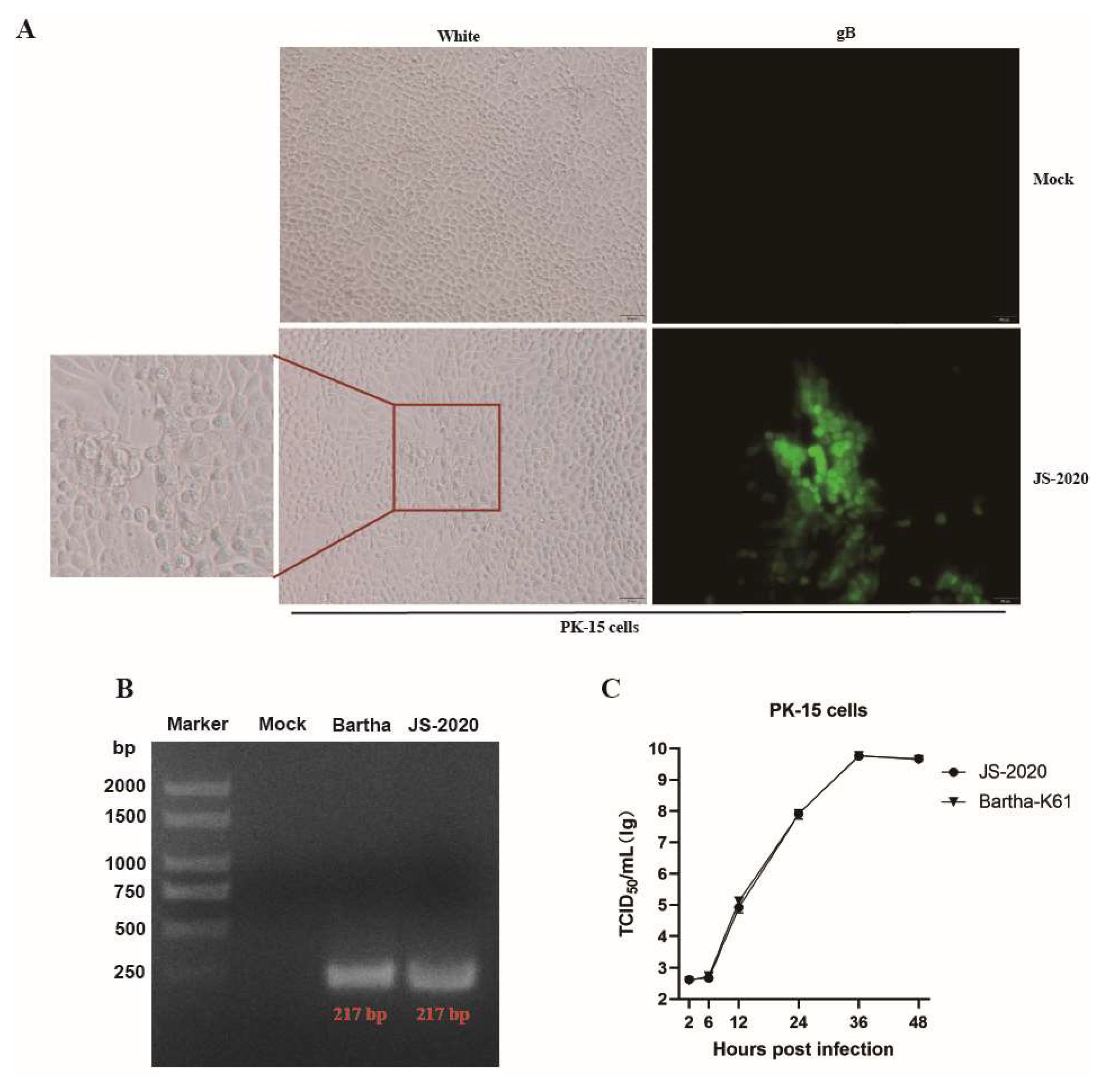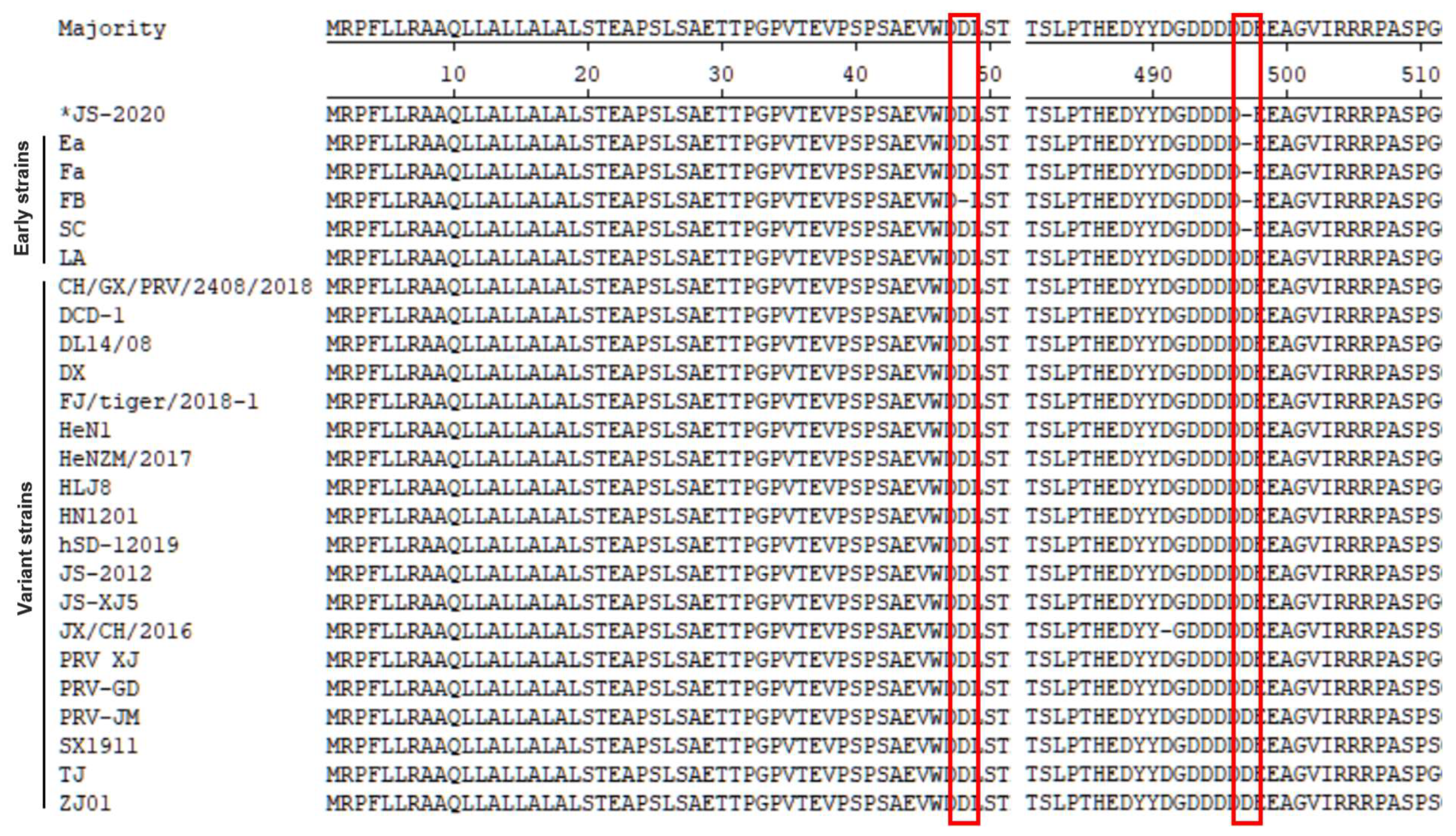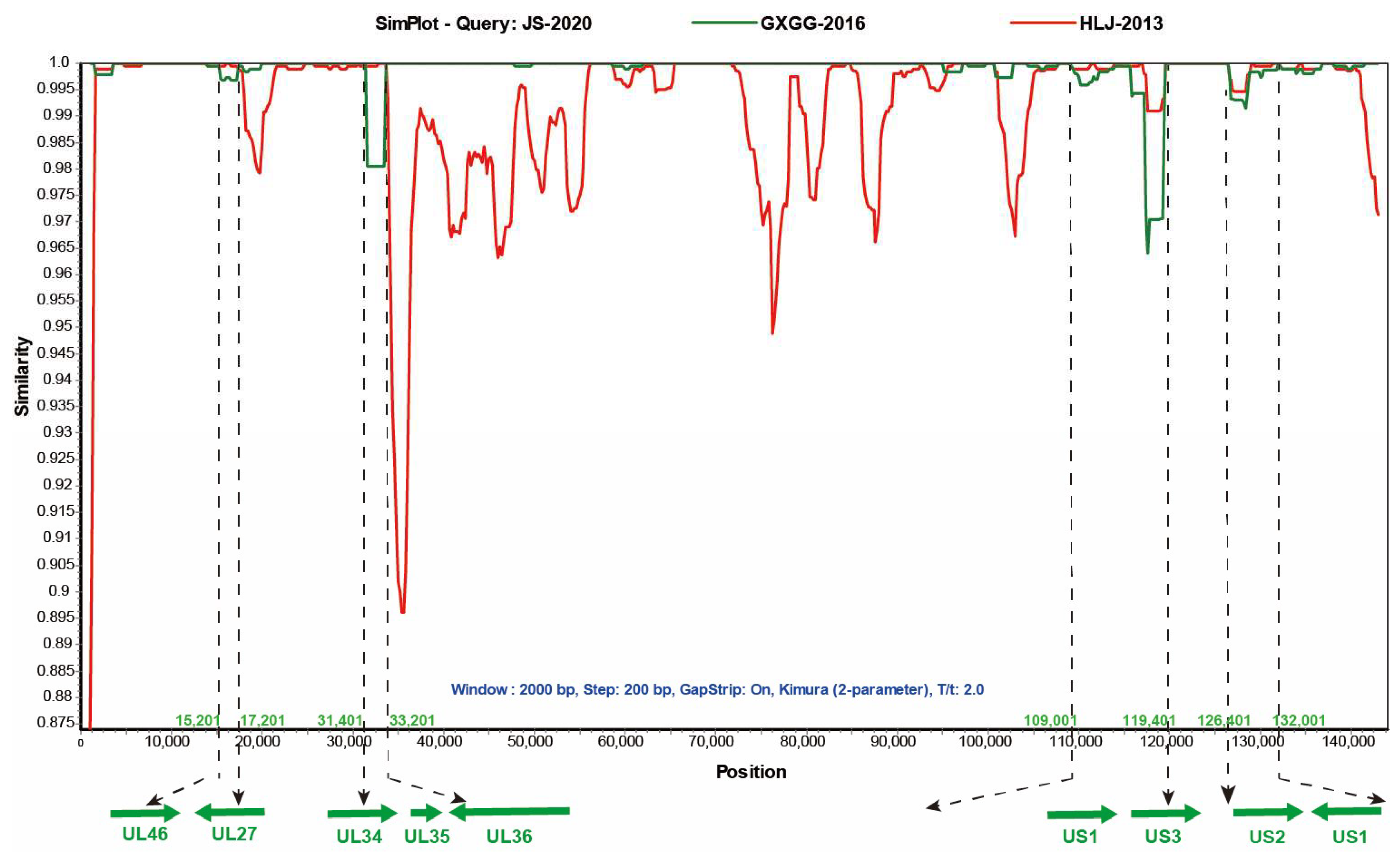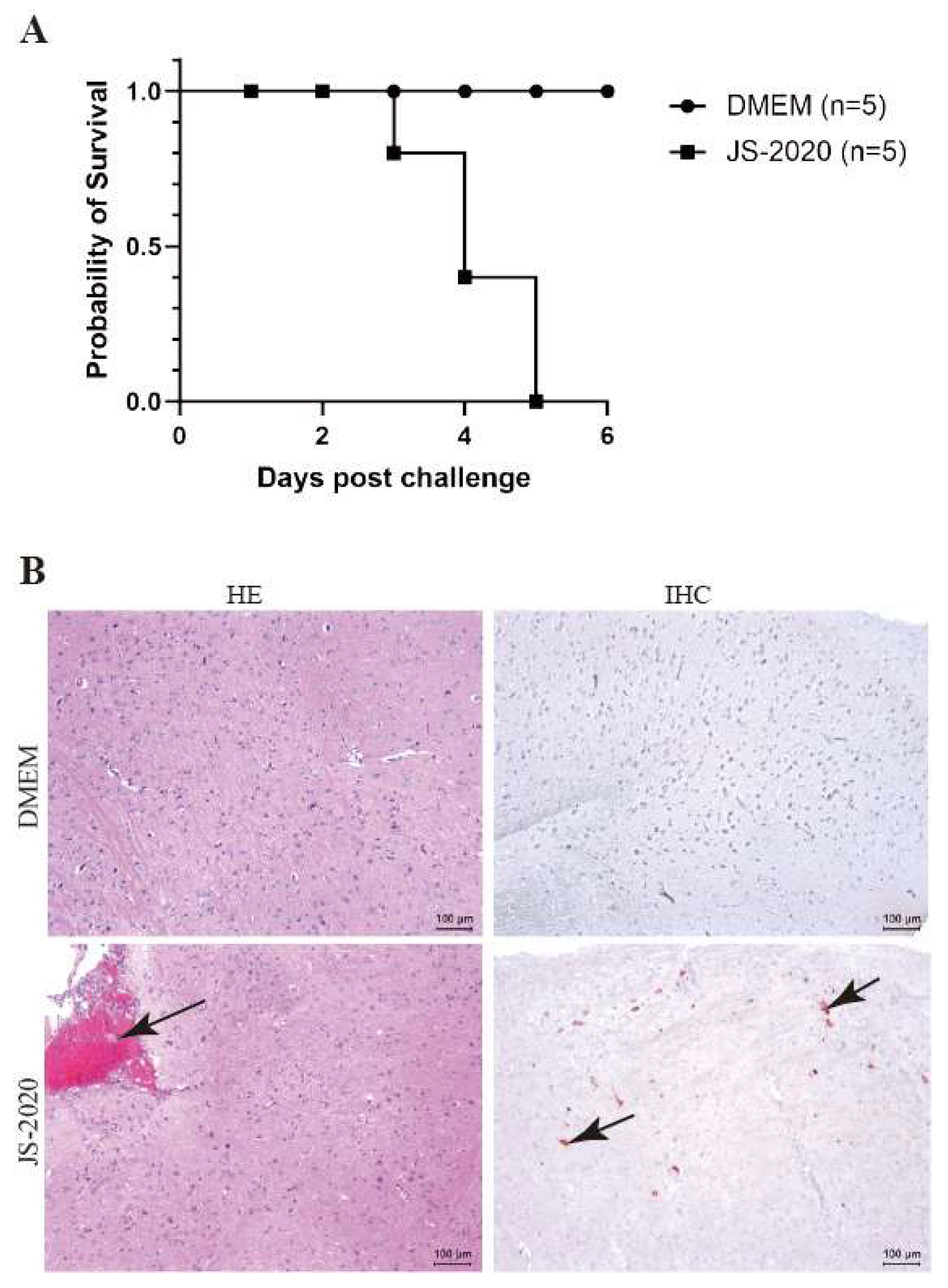Isolation and Characterization of a Novel Recombinant Classical Pseudorabies Virus in the Context of the Variant Strains Pandemic in China
Abstract
:1. Introduction
2. Materials and Methods
2.1. Cells and Virus Infection
2.2. PCR Identification and Growth Curves
2.3. Immunofluorescence
2.4. Complete Genome Sequencing and Analysis
2.5. Amino Acid Variations Analysis
2.6. Recombination Analysis
2.7. Animal Experiments
2.8. Histopathology and Immunohistochemistry Staining
3. Results
3.1. Isolation and Identification of PRV JS-2020 Strain
3.2. Genomic Characterization of the JS-2020 Strain
3.3. Amino Acid Variations Analysis of the JS-2020 Strain
3.4. Recombination Analysis
3.5. Pathogenicity Analysis
4. Discussion
Author Contributions
Funding
Institutional Review Board Statement
Data Availability Statement
Conflicts of Interest
References
- Pomeranz, L.E.; Reynolds, A.E.; Hengartner, C.J. Molecular biology of pseudorabies virus: Impact on neurovirology and veterinary medicine. Microbiol. Mol. Biol. Rev. 2005, 69, 462–500. [Google Scholar] [CrossRef]
- Klupp, B.G.; Hengartner, C.J.; Mettenleiter, T.C.; Enquist, L.W. Complete, annotated sequence of the pseudorabies virus genome. J. Virol. 2004, 78, 424–440. [Google Scholar] [CrossRef]
- Szpara, M.L.; Tafuri, Y.R.; Parsons, L.; Shamim, S.R.; Verstrepen, K.J.; Legendre, M.; Enquist, L.W. A wide extent of inter-strain diversity in virulent and vaccine strains of alphaherpesviruses. PLoS Pathog. 2011, 7, e1002282. [Google Scholar] [CrossRef]
- Zheng, H.H.; Fu, P.F.; Chen, H.Y.; Wang, Z.Y. Pseudorabies Virus: From Pathogenesis to Prevention Strategies. Viruses 2022, 14, 1638. [Google Scholar] [CrossRef]
- Zhou, J.; Li, S.; Wang, X.; Zou, M.; Gao, S. Bartha-k61 vaccine protects growing pigs against challenge with an emerging variant pseudorabies virus. Vaccine 2017, 35, 1161–1166. [Google Scholar] [CrossRef]
- Yu, X.; Zhou, Z.; Hu, D.; Zhang, Q.; Han, T.; Li, X.; Gu, X.; Yuan, L.; Zhang, S.; Wang, B.; et al. Pathogenic pseudorabies virus, China, 2012. Emerg. Infect. Dis. 2014, 20, 102–104. [Google Scholar] [CrossRef]
- An, T.Q.; Peng, J.M.; Tian, Z.J.; Zhao, H.Y.; Li, N.; Liu, Y.M.; Chen, J.Z.; Leng, C.L.; Sun, Y.; Chang, D.; et al. Pseudorabies virus variant in Bartha-K61-vaccinated pigs, China, 2012. Emerg. Infect. Dis. 2013, 19, 1749–1755. [Google Scholar] [CrossRef]
- Sun, Y.; Liang, W.; Liu, Q.; Zhao, T.; Zhu, H.; Hua, L.; Peng, Z.; Tang, X.; Stratton, C.W.; Zhou, D.; et al. Epidemiological and genetic characteristics of swine pseudorabies virus in mainland China between 2012 and 2017. PeerJ 2018, 6, e5785. [Google Scholar] [CrossRef]
- Bo, Z.; Miao, Y.; Xi, R.; Gao, X.; Miao, D.; Chen, H.; Jung, Y.S.; Qian, Y.; Dai, J. Emergence of a novel pathogenic recombinant virus from Bartha vaccine and variant pseudorabies virus in China. Transbound. Emerg. Dis. 2021, 68, 1454–1464. [Google Scholar] [CrossRef]
- Luo, Y.; Li, N.; Cong, X.; Wang, C.H.; Du, M.; Li, L.; Zhao, B.; Yuan, J.; Liu, D.D.; Li, S.; et al. Pathogenicity and genomic characterization of a pseudorabies virus variant isolated from Bartha-K61-vaccinated swine population in China. Vet. Microbiol. 2014, 174, 107–115. [Google Scholar] [CrossRef]
- Tan, L.; Yao, J.; Yang, Y.; Luo, W.; Yuan, X.; Yang, L.; Wang, A. Current Status and Challenge of Pseudorabies Virus Infection in China. Virol. Sin. 2021, 36, 588–607. [Google Scholar] [CrossRef] [PubMed]
- Tong, W.; Liu, F.; Zheng, H.; Liang, C.; Zhou, Y.J.; Jiang, Y.F.; Shan, T.L.; Gao, F.; Li, G.X.; Tong, G.Z. Emergence of a Pseudorabies virus variant with increased virulence to piglets. Vet. Microbiol. 2015, 181, 236–240. [Google Scholar] [CrossRef] [PubMed]
- Wang, C.H.; Yuan, J.; Qin, H.Y.; Luo, Y.; Cong, X.; Li, Y.; Chen, J.; Li, S.; Sun, Y.; Qiu, H.J. A novel gE-deleted pseudorabies virus (PRV) provides rapid and complete protection from lethal challenge with the PRV variant emerging in Bartha-K61-vaccinated swine population in China. Vaccine 2014, 32, 3379–3385. [Google Scholar] [CrossRef] [PubMed]
- Yang, Q.Y.; Sun, Z.; Tan, F.F.; Guo, L.H.; Wang, Y.Z.; Wang, J.; Wang, Z.Y.; Wang, L.L.; Li, X.D.; Xiao, Y.; et al. Pathogenicity of a currently circulating Chinese variant pseudorabies virus in pigs. World J. Virol. 2016, 5, 23–30. [Google Scholar] [CrossRef] [PubMed]
- Gu, Z.; Dong, J.; Wang, J.; Hou, C.; Sun, H.; Yang, W.; Bai, J.; Jiang, P. A novel inactivated gE/gI deleted pseudorabies virus (PRV) vaccine completely protects pigs from an emerged variant PRV challenge. Virus Res. 2015, 195, 57–63. [Google Scholar] [CrossRef]
- Wang, T.; Xiao, Y.; Yang, Q.; Wang, Y.; Sun, Z.; Zhang, C.; Yan, S.; Wang, J.; Guo, L.; Yan, H.; et al. Construction of a gE-Deleted Pseudorabies Virus and Its Efficacy to the New-Emerging Variant PRV Challenge in the Form of Killed Vaccine. Biomed. Res. Int. 2015, 2015, 684945. [Google Scholar] [CrossRef]
- Zhang, C.; Guo, L.; Jia, X.; Wang, T.; Wang, J.; Sun, Z.; Wang, L.; Li, X.; Tan, F.; Tian, K. Construction of a triple gene-deleted Chinese Pseudorabies virus variant and its efficacy study as a vaccine candidate on suckling piglets. Vaccine 2015, 33, 2432–2437. [Google Scholar] [CrossRef]
- Yan, S.; Huang, B.; Bai, X.; Zhou, Y.; Guo, L.; Wang, T.; Shan, Y.; Wang, Y.; Tan, F.; Tian, K. Construction and Immunogenicity of a Recombinant Pseudorabies Virus Variant With TK/gI/gE/11k/28k Deletion. Front. Vet. Sci. 2021, 8, 797611. [Google Scholar] [CrossRef] [PubMed]
- Ye, C.; Guo, J.C.; Gao, J.C.; Wang, T.Y.; Zhao, K.; Chang, X.B.; Wang, Q.; Peng, J.M.; Tian, Z.J.; Cai, X.H.; et al. Genomic analyses reveal that partial sequence of an earlier pseudorabies virus in China is originated from a Bartha-vaccine-like strain. Virology 2016, 491, 56–63. [Google Scholar] [CrossRef]
- Qin, Y.; Qin, S.; Huang, X.; Xu, L.; Ouyang, K.; Chen, Y.; Wei, Z.; Huang, W. Isolation and identification of two novel pseudorabies viruses with natural recombination or TK gene deletion in China. Vet. Microbiol. 2023, 280, 109703. [Google Scholar] [CrossRef]
- Klopfleisch, R.; Klupp, B.G.; Fuchs, W.; Kopp, M.; Teifke, J.P.; Mettenleiter, T.C. Influence of pseudorabies virus proteins on neuroinvasion and neurovirulence in mice. J. Virol. 2006, 80, 5571–5576. [Google Scholar] [CrossRef]
- Klopfleisch, R.; Teifke, J.P.; Fuchs, W.; Kopp, M.; Klupp, B.G.; Mettenleiter, T.C. Influence of tegument proteins of pseudorabies virus on neuroinvasion and transneuronal spread in the nervous system of adult mice after intranasal inoculation. J. Virol. 2004, 78, 2956–2966. [Google Scholar] [CrossRef] [PubMed]
- Li, Y.; Yan, S.; Li, X.; Yang, Q.; Guo, L.; Wang, Y.; Xiao, Y.; Tan, F.; Li, X.; Tian, K. From mouse to pig: Is PRV vaccine safe across two species? Virus Res. 2017, 236, 44–49. [Google Scholar] [CrossRef] [PubMed]
- Peeters, B.; de Wind, N.; Hooisma, M.; Wagenaar, F.; Gielkens, A.; Moormann, R. Pseudorabies virus envelope glycoproteins gp50 and gII are essential for virus penetration, but only gII is involved in membrane fusion. J. Virol. 1992, 66, 894–905. [Google Scholar] [CrossRef]
- Rauh, I.; Mettenleiter, T.C. Pseudorabies virus glycoproteins gII and gp50 are essential for virus penetration. J. Virol. 1991, 65, 5348–5356. [Google Scholar] [CrossRef] [PubMed]
- Zaripov, M.M.; Morenkov, O.S.; Fodor, N.; Braun, A.; Schmatchenko, V.V.; Fodor, I.; Brown, A. Distribution of B-cell epitopes on the pseudorabies virus glycoprotein B. J. Gen. Virol. 1999, 80 Pt 3, 537–541. [Google Scholar] [CrossRef]
- Rue, C.A.; Ryan, P. Pseudorabies virus glycoprotein C attachment-proficient revertants isolated through a simple, targeted mutagenesis scheme. J. Virol. Methods 2008, 151, 101–106. [Google Scholar] [CrossRef]
- Li, A.; Lu, G.; Qi, J.; Wu, L.; Tian, K.; Luo, T.; Shi, Y.; Yan, J.; Gao, G.F. Structural basis of nectin-1 recognition by pseudorabies virus glycoprotein D. PLoS Pathog. 2017, 13, e1006314. [Google Scholar] [CrossRef]
- Zhang, T.; Liu, Y.; Chen, Y.; Wang, J.; Feng, H.; Wei, Q.; Zhao, S.; Yang, S.; Liu, D.; Zhang, G. A monoclonal antibody neutralizes pesudorabies virus by blocking gD binding to the receptor nectin-1. Int. J. Biol. Macromol. 2021, 188, 359–368. [Google Scholar] [CrossRef]
- Ch’ng, T.H.; Enquist, L.W. Neuron-to-cell spread of pseudorabies virus in a compartmented neuronal culture system. J. Virol. 2005, 79, 10875–10889. [Google Scholar] [CrossRef]
- Kratchmarov, R.; Kramer, T.; Greco, T.M.; Taylor, M.P.; Ch’ng, T.H.; Cristea, I.M.; Enquist, L.W. Glycoproteins gE and gI are required for efficient KIF1A-dependent anterograde axonal transport of alphaherpesvirus particles in neurons. J. Virol. 2013, 87, 9431–9440. [Google Scholar] [CrossRef] [PubMed]
- Liu, H.; Shi, Z.; Liu, C.; Wang, P.; Wang, M.; Wang, S.; Liu, Z.; Wei, L.; Sun, Z.; He, X.; et al. Implication of the Identification of an Earlier Pseudorabies Virus (PRV) Strain HLJ-2013 to the Evolution of Chinese PRVs. Front. Microbiol. 2020, 11, 612474. [Google Scholar] [CrossRef] [PubMed]
- Huang, J.; Tang, W.; Wang, X.; Zhao, J.; Peng, K.; Sun, X.; Li, S.; Kuang, S.; Zhu, L.; Zhou, Y.; et al. The Genetic Characterization of a Novel Natural Recombinant Pseudorabies Virus in China. Viruses 2022, 14, 978. [Google Scholar] [CrossRef] [PubMed]
- Hu, R.; Wang, L.; Liu, Q.; Hua, L.; Huang, X.; Zhang, Y.; Fan, J.; Chen, H.; Song, W.; Liang, W.; et al. Whole-Genome Sequence Analysis of Pseudorabies Virus Clinical Isolates from Pigs in China between 2012 and 2017 in China. Viruses 2021, 13, 1322. [Google Scholar] [CrossRef]






| Strain | Accession Number | Country | Isolation Date |
|---|---|---|---|
| HeNZM/2017 | MW560175.1 | China | 2017 |
| JX/CH/2016 | MK806387.1 | China | 2016 |
| LA | KU552118.1 | China | 1997 |
| Ea | KU315430.1 | China | 1990 |
| Fa | KM189913.1 | China | 2012 |
| FB | ON005002.1 | China | 1986 |
| hSD-1/2019 | MT468550.1 | China | 2019 |
| PRV XJ | MW893682.1 | China | 2015 |
| PRV-GD | OK338076.1 | China | 2021 |
| SX1911 | OP376823.1 | China | 2019 |
| Becker | JF797219.1 | USA | 1970 |
| SC | KT809429.1 | China | 1986 |
| Bartha | JF797217.1 | Hungary | 1961 |
| GXGG-2016 | OP605538.1 | China | 2016 |
| HLJ-2013 | MK080279.1 | China | 2013 |
| JS-2020 | OR271601 | China | 2020 |
| Region | Start (5′) | End (3′) | Length (bp) |
|---|---|---|---|
| UL | 1 | 101,287 | 101,287 |
| IR | 101,288 | 117,675 | 16,388 |
| US | 117,676 | 126,858 | 9183 |
| TR | 126,858 | 143,246 | 16,388 |
| Nucleotide Homology % (Complete Genome) | |||||||||||||||
|---|---|---|---|---|---|---|---|---|---|---|---|---|---|---|---|
| PRV Strain | JX/CH/2016 | LA | Ea | Fa | FB | hSD-1/2019 | PRV XJ | PRV-GD | SX1911 | Becke | SC | Bartha | HLJ-2013 | GXGG-2016 | JS-2020 |
| HeNZM/2017 | 97.1 | 94.1 | 96.4 | 96.1 | 94.6 | 96.6 | 96.9 | 95.6 | 97.2 | 91.7 | 95.7 | 90.3 | 95.5 | 96.3 | 96.8 |
| JX/CH/2016 | 94.7 | 97.1 | 97 | 95.4 | 97.6 | 98.4 | 95.6 | 97.8 | 91.9 | 96.7 | 90.9 | 96.5 | 97.1 | 97.8 | |
| LA | 94.9 | 94.8 | 93.5 | 94.3 | 94.7 | 93.3 | 94.3 | 92.1 | 94.2 | 90.6 | 94.7 | 94.7 | 95.1 | ||
| Ea | 98.3 | 95.8 | 96.4 | 96.9 | 94.7 | 96.6 | 91.9 | 96.9 | 90.9 | 97.1 | 99.2 | 99 | |||
| Fa | 96.9 | 96.1 | 96.6 | 94.6 | 96.5 | 91.8 | 96.9 | 90.8 | 97.1 | 98.2 | 98.8 | ||||
| FB | 95.5 | 95.1 | 94 | 95.6 | 91.1 | 95.7 | 90.1 | 95.7 | 95.8 | 96.4 | |||||
| hSD-1/2019 | 98.6 | 96.3 | 98.3 | 91.4 | 97.8 | 90.1 | 96.1 | 96.4 | 97 | ||||||
| PRV XJ | 95.7 | 98 | 91.8 | 97.4 | 90.4 | 96.4 | 96.8 | 97.5 | |||||||
| PRV-GD | 96.7 | 90.8 | 95.4 | 88.9 | 94.4 | 94.6 | 95.3 | ||||||||
| SX1911 | 92.1 | 97.2 | 90.5 | 96.3 | 96.6 | 97.3 | |||||||||
| Becker | 92 | 93.8 | 93 | 91.7 | 92.3 | ||||||||||
| SC | 91.1 | 97.3 | 96.9 | 97.6 | |||||||||||
| Bartha | 92.3 | 90.8 | 91.3 | ||||||||||||
| HLJ-2013 | 97.1 | 97.9 | |||||||||||||
| GXGG-2016 | 98.9 | ||||||||||||||
| Protein Name | Number (aa) | Amino Acid Residues and Location |
|---|---|---|
| UL50 | 1 | 24 (+E) |
| UL49.5 | 1 | 4 (+S) |
| UL48 | 4 | R161Q T216M T271A H397P |
| UL47 | 7 | P399A V404L D406E T411A 414–415(TL > AV) P419A |
| UL46 | 2 | C494Y A666T |
| UL27 | 6 | P735L H560Q G393D V114G T112P |
| UL28 | 1 | V428G |
| UL30 | 1 | P150L |
| UL32 | 1 | T402A |
| UL34 | 1 | A78V |
| UL35 | 1 | P102S |
| UL36 | 34 | G3167D 2510–2512(ΔAPP) K2267T 279–280(ΔQS) 942–968(GAAGRAVGGRGGGRGDARAGCARSPTR>ALQAALSAAVAAAVEMLGRLRAQPDE |
| UL39 | 1 | L571F |
| UL41 | 2 | S218T Y11H |
| UL15 | 2 | F545S K169E |
| UL17 | 1 | D209A |
| UL10 | 4 | L200H V158A R116Q Q107R |
| UL9 | 1 | C218R |
| UL3.5 | 1 | S195P |
| UL2 | 2 | 42–43(ΔGA) |
| EP0 | 3 | A270G C200S V161M |
| IE180 | 7 | V999A Q943E N908K P865S V757A T724A Q524R |
| US1 | 21 | P81A G136C K236E 342–343 (+EDEDEDEDEDEDEDEDED) |
| US3 | 5 | S24G R115P P135R V177D G214A |
| US6 | 2 | F169S S278R |
| US7 | 1 | V148L |
| US2 | 1 | Y265S |
| PRV Strain | Homology of Amino Acid Sequence (%) | |||||
|---|---|---|---|---|---|---|
| gB | gC | gD | gE | gI | TK | |
| Bartha | 96.5 | 92.7 | 97.3 | - | - | 99.4 |
| CH/GX/PRV/2408/2018 | 99.3 | 99.4 | 99.8 | 99.3 | 100.0 | 100.0 |
| DCD-1 | 99.2 | 99.4 | 99.8 | 99 | 100.0 | 100.0 |
| DL14/08 | 99.3 | 99.4 | 99.8 | 99.5 | 100.0 | 99.7 |
| DX | 99.2 | 99.4 | 99.8 | 99.1 | 99.5 | 100.0 |
| Ea | 99.5 | 100.0 | 99.5 | 100.0 | 99.7 | 100.0 |
| Fa | 99.7 | 100.0 | 100.0 | 100.0 | 100.0 | 100.0 |
| FB | 98.3 | 97.3 | 99.8 | 99.1 | 98.6 | 99.7 |
| FJ/tiger/2018-1 | 99.5 | 99.4 | 99.8 | 99.5 | 100.0 | 99.7 |
| GXGG-2016 | 99.7 | 100.0 | 100.0 | 83.9 | 100.0 | - |
| HeN1 | 99.3 | 99.4 | 99.8 | 98.8 | 100.0 | 100.0 |
| HeNZM/2017 | 99.3 | 99.4 | 99.8 | 99.3 | 100.0 | 100.0 |
| HLJ-2013 | 97.8 | 94.4 | 100.0 | 99.8 | 100.0 | 99.4 |
| HLJ8 | 99.3 | 99.4 | 99.8 | 99.3 | 100.0 | 100.0 |
| HN1201 | 99.3 | 99.4 | 99.8 | 99.1 | 100.0 | 100.0 |
| hSD-1/2019 | 99.3 | 99.4 | 99.8 | 99.1 | 100.0 | 100.0 |
| JS-2012 | 99.3 | 99.2 | 99.8 | 99.1 | 100.0 | 100.0 |
| JS-XJ5 | 99.3 | 99.2 | 99.8 | 99.3 | 100.0 | 100.0 |
| JX/CH/2016 | 99.2 | 99.2 | 99.8 | 99.1 | 100.0 | 100.0 |
| LA | 98.8 | 98.3 | 99.7 | 99.5 | 98.6 | 100.0 |
| PRV XJ | 99.2 | 99.4 | 99.8 | 99.1 | 100.0 | 100.0 |
| PRV-GD | 99.3 | 99.4 | 99.8 | 99.1 | 100.0 | 100.0 |
| PRV-JM | 99.3 | 99.4 | 99.8 | 99.1 | 100.0 | 100.0 |
| SC | 99.7 | 94.4 | 100.0 | 100.0 | 100.0 | 99.4 |
| SX1911 | 99.1 | 99.4 | 99.8 | 99.1 | 100.0 | 100.0 |
| TJ | 99.3 | 99.4 | 99.8 | 99.3 | 99.7 | 100.0 |
| ZJ01 | 99.2 | 99.4 | 99.5 | 98.4 | 97.3 | 100.0 |
Disclaimer/Publisher’s Note: The statements, opinions and data contained in all publications are solely those of the individual author(s) and contributor(s) and not of MDPI and/or the editor(s). MDPI and/or the editor(s) disclaim responsibility for any injury to people or property resulting from any ideas, methods, instructions or products referred to in the content. |
© 2023 by the authors. Licensee MDPI, Basel, Switzerland. This article is an open access article distributed under the terms and conditions of the Creative Commons Attribution (CC BY) license (https://creativecommons.org/licenses/by/4.0/).
Share and Cite
Lian, Z.; Liu, P.; Zhu, Z.; Sun, Z.; Yu, X.; Deng, J.; Li, R.; Li, X.; Tian, K. Isolation and Characterization of a Novel Recombinant Classical Pseudorabies Virus in the Context of the Variant Strains Pandemic in China. Viruses 2023, 15, 1966. https://doi.org/10.3390/v15091966
Lian Z, Liu P, Zhu Z, Sun Z, Yu X, Deng J, Li R, Li X, Tian K. Isolation and Characterization of a Novel Recombinant Classical Pseudorabies Virus in the Context of the Variant Strains Pandemic in China. Viruses. 2023; 15(9):1966. https://doi.org/10.3390/v15091966
Chicago/Turabian StyleLian, Zhengmin, Panrao Liu, Zhenbang Zhu, Zhe Sun, Xiuling Yu, Junhua Deng, Ruichao Li, Xiangdong Li, and Kegong Tian. 2023. "Isolation and Characterization of a Novel Recombinant Classical Pseudorabies Virus in the Context of the Variant Strains Pandemic in China" Viruses 15, no. 9: 1966. https://doi.org/10.3390/v15091966





